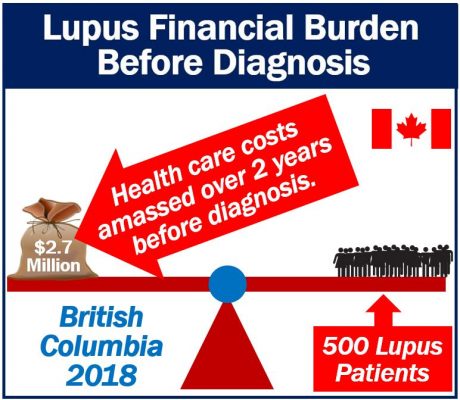Lupus places a major but hidden financial burden on health care systems. The financial strain is there even before patients receive a diagnosis, a new study by Arthritis Research Canada has found.
Lupus, systemic lupus erythematosus, or SLE is a chronic, autoimmune disease. It is also a systemic disease. Chronic means long-term, while autoimmune means the body’s immune system attacks good cells and tissue. It should not do that. Systemic means that it affects the whole body or many different parts of the body simultaneously.
Lupus patients may have several different signs and symptoms. This is because it affects many parts of the body. Unfortunately, it is also a very difficult disease to diagnose accurately at first.
Financial burden starts years before diagnosis
The health care costs that people with lupus experience in the years leading up to a diagnosis are significant. The financial burden is much higher than the average health care costs for the general population.
Researcher Dr. Antonio Aviña-Zubieta explained:
“The spike in pre-diagnosis costs is partly due to tests involved in seeking care for an undiagnosed disease. The timeline from initial symptoms to full-blown lupus often spans two years and, sometimes, even longer.”
Dr. Antonio Aviña-Zubieta is a senior research scientist at Arthritis Research Canada. He is also a BC Lupus Society research scholar.

$2.7 million financial burden for 500 people
About five hundred adults will be diagnosed with lupus in British Columbia in 2018. However, those people will have amassed more than $2.7 million in additional health care costs over the 2-year period before diagnosis.
Most of them are young women. Lupus affects nine times as many women as men.
Across the whole of Canada, these additional health care costs from lupus exceed $21 million annually.
Early diagnosis reduces financial burden
Regarding these figures, Dr. Aviña-Zubieta said:
“These numbers reveal that early detection is key to reducing the burden that lupus places on health care systems around the world.”
“Earlier diagnosis and intervention has also been reducing complications or damage.”
However, very little research has been conducted on the impact of lupus before diagnosis. Specifically, the financial impact of the disease on the health care system.

This latest study is the first to include estimates of medication, hospitalization, and outpatient costs before a lupus diagnosis. In other words, it is the first study to focus on the financial burden that existed beforehand.
Dr. Aviña-Zubieta and colleagues used data from the BC Ministry of Health. They compared newly-diagnosed lupus patients with a random sample of people without lupus. The people in both groups were all British Columbia residents.
The researchers focused on the health care costs of the people in the two groups.
Identifying lupus earlier
Regarding the findings of this latest study, Dr. Aviña-Zubieta said:
“SLE is difficult to diagnose but identifying it earlier could reduce costs and improve patient care and the lives of people with SLE.”
In another study, Chinese researchers reported earlier this month that heart problems are common among newly-diagnosed lupus patients.

